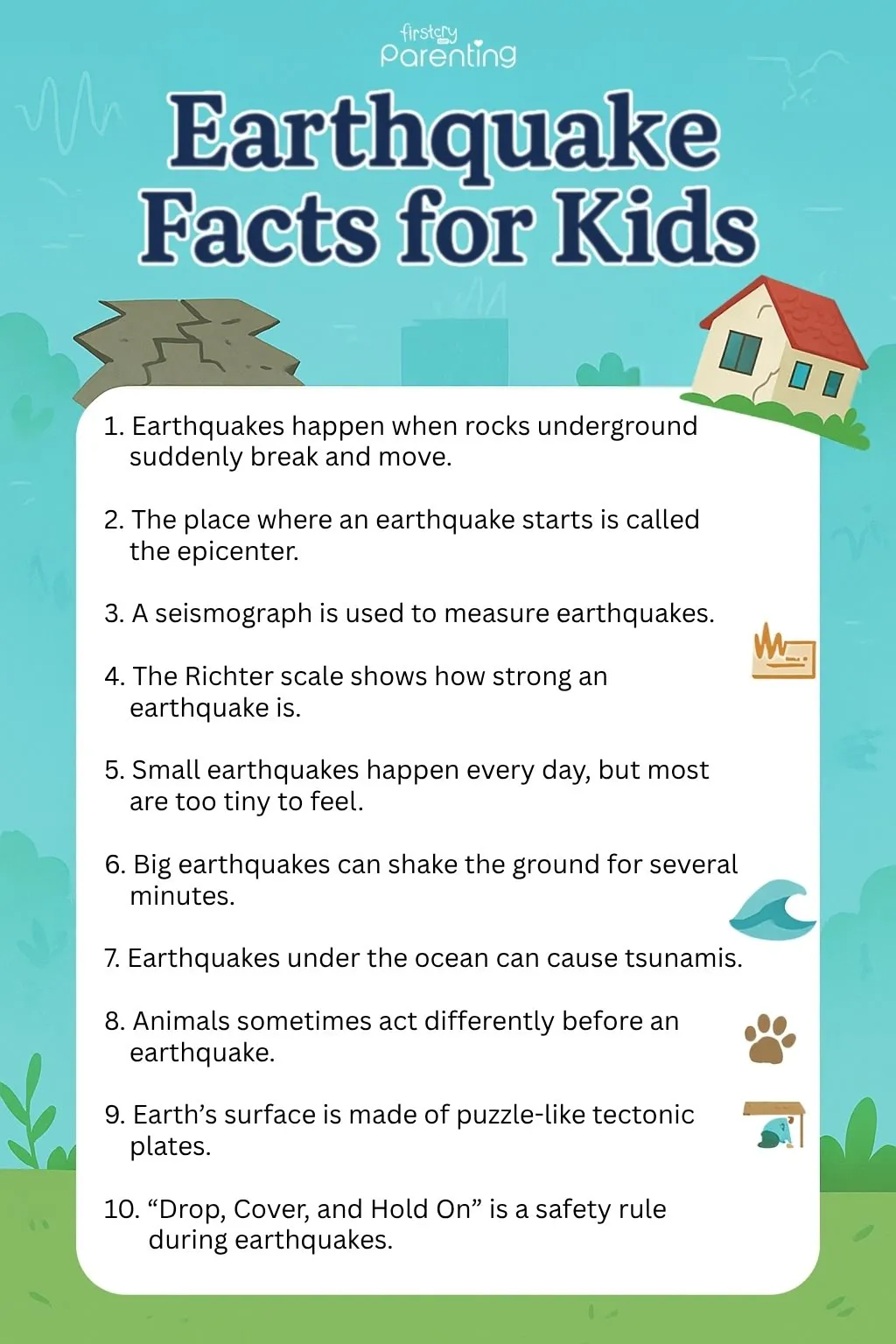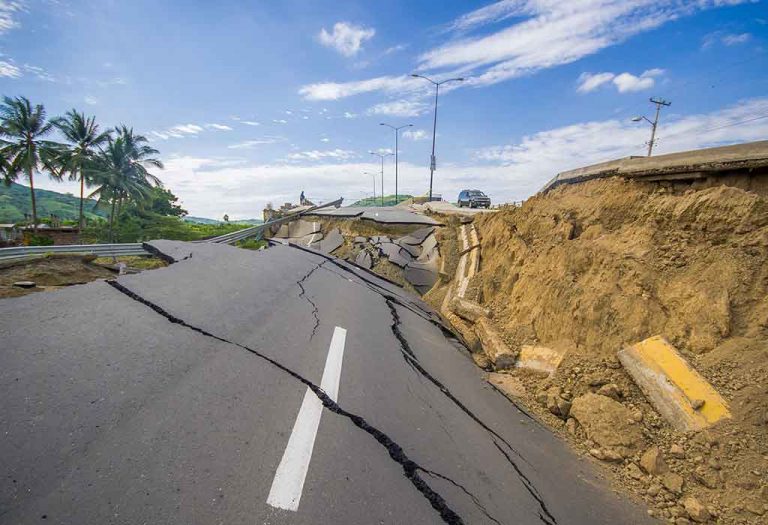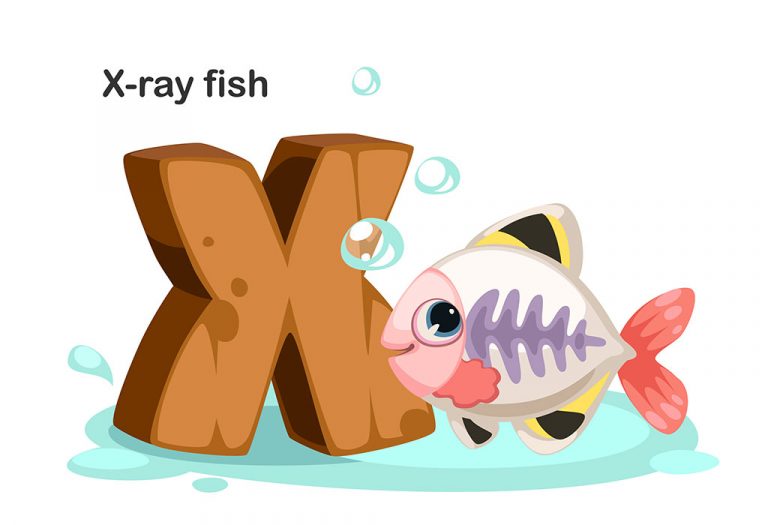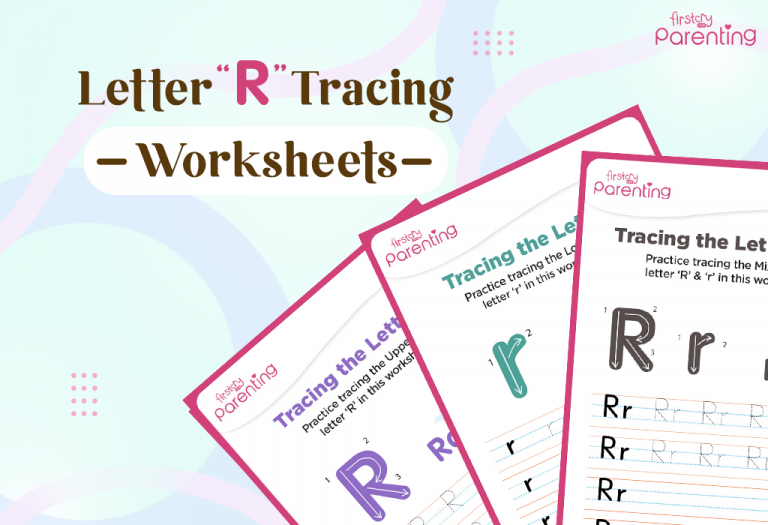Earthquakes Facts for Kids – Types, Causes & Safety Measures
An earthquake occurs when the Earth’s surface shakes violently due to sudden movements in its tectonic plates. This shaking is caused by the movement in the Earth’s outermost layer, known as the crust, which can release massive amounts of energy. The occurrence of an earthquake is a natural disaster, but it is frightening and can cause significant damage to buildings, roads, and even entire communities. Earthquakes can also trigger other hazards like tsunamis or landslides, making them even more dangerous. If you want to educate your child about earthquakes, we have some child-friendly facts on earthquakes that you can read to your child without frightening them. Here are some interesting earthquake facts for kids.
What Is an Earthquake and Why Does It Happen?
An earthquake is a sudden and violent shaking of the ground caused by the movement of tectonic plates beneath the Earth’s surface (1). These massive slabs of rock constantly shift, collide, or slide past each other, creating stress along fault lines. When the pressure becomes too great, it releases in the form of seismic waves, making the ground tremble. Earthquakes can also occur due to volcanic activity or human actions like mining. The strength of an earthquake is measured using the Richter scale, with stronger quakes capable of causing widespread destruction.
Different Types of Earthquakes
Earthquakes can vary depending on their cause and location. Here are the main types explained in simple terms:
- Tectonic Earthquakes: These are the most common type, occurring when tectonic plates suddenly slip past each other along fault lines. The released energy causes the ground to shake, sometimes violently.
- Volcanic Earthquakes: These occur near active volcanoes when magma moves underground before eruptions. While usually smaller than tectonic quakes, they can signal impending volcanic activity.
- Collapse Earthquakes: These happen when underground spaces like mines or caves collapse suddenly. They’re typically smaller but can still cause damage right above the collapse area.
- Explosion Earthquakes: Caused by powerful human-made explosions like nuclear tests, these create seismic waves similar to natural earthquakes but are usually more localized.
- Induced Earthquakes: Human activities like fracking or filling reservoirs can trigger these quakes. They often occur in areas not normally prone to earthquakes.
What Are Tectonic Plates and Faults?
The Earth’s outer shell (called the lithosphere) is broken into 15-20 large tectonic plates that slowly move across the planet’s hot, semi-liquid mantle layer (2). Heat from Earth’s core creates currents that make these plates shift, sometimes pushing them together or pulling them apart.
Where these plates interact, they form cracks called faults – the boundaries where earthquakes occur. These fractures can be tiny or stretch across continents. Earthquakes happen when built-up pressure causes sudden movement along these fault lines. The main fault types involve different movement patterns: – normal, reverse, and strike-slip. Normal faults occur in regions where there has been an expansion in the Earth’s crust and reverse faults take place in areas where the Earth’s crust contracts. Strike-slip faults occur when two sides of a fault slip horizontally and become a steep on both sides (3).
Causes of Earthquakes
Earthquakes occur when energy is suddenly released along fractures in Earth’s crust. While tectonic plate movement is the primary cause, several other factors can trigger seismic activity (4).
- Tectonic Plate Movement: Most earthquakes happen when plates collide, separate, or slide past each other
- Volcanic Activity: Magma movement beneath volcanoes can create pressure and vibrations
- Human Activities: Mining, reservoir construction, and fracking can induce seismic events
- Underground Collapses: Cave-ins of mines or natural caverns generate minor tremors
- Meteor Impacts: Rare but powerful impacts can create earthquake-like shockwaves
What Are the Hypocenter and Epicenter?
Every earthquake starts at a precise spot underground called the hypocenter (or focus). This is where the rock actually breaks and releases energy. The point on the Earth’s surface directly above the hypocenter is called the epicenter—this is where the quake is usually felt the strongest (5).
The deeper the hypocenter, the more the energy spreads out before reaching the surface, often making deep quakes less damaging than shallow ones. For example, a quake with a hypocenter 10 km below a city will shake harder than one 300 km deep.
What Are Aftershocks and Foreshocks?
Earthquakes are always followed by an aftershock and sometimes even a foreshock, which are both of lower magnitudes than the mainshock.
Aftershocks are smaller earthquakes that happen after the main quake, as the Earth’s crust adjusts to the changes caused by the initial slip. These can continue for days, weeks, or even years, gradually becoming weaker over time.
Foreshocks are smaller tremors that sometimes occur before the main earthquake. While they can serve as a warning, they’re only recognized as foreshocks after the larger quake happens—there’s no way to predict if a small shake will be followed by a bigger one (6).
How Are Earthquakes Measured?
Earthquakes are measured using scientific instruments and scales that track their size, strength, and impact. These measurements help scientists understand the quake’s power and potential damage (7).
- Seismographs: Instruments that record ground movements, the magnitude and length of earthquakes and produce seismograms
- Richter Scale: Measures the earthquake’s magnitude (energy released) on a logarithmic scale
- Moment Magnitude Scale (Mw): More accurate modern scale for larger earthquakes
- Modified Mercalli Intensity Scale: Rates shaking intensity and damage (I to XII)
- Depth Measurement: Calculates how far below the surface the quake started (hypocenter)
- Aftershock Tracking: Monitors smaller quakes after the main event to assess risks
Ways to Stay Safe During an Earthquake
Earthquakes can strike suddenly without warning, making preparedness crucial. Knowing what to do before, during, and after can save lives and reduce injuries.
Before an Earthquake
- Secure heavy furniture like bookshelves and cabinets to the walls
- Prepare an emergency kit with food, water, medicines, and first aid supplies
- Identify safe spots in each room (under sturdy tables, away from windows)
- Practice earthquake drills with your family or coworkers
- Know how to turn off gas, water, and electricity in case of leaks or damage
During an Earthquake
- Drop, Cover, and Hold On: Stay low, protect your head, and hold onto sturdy furniture
- Stay indoors until shaking stops; avoid doorways (they’re no safer than other areas)
- Stay away from windows, mirrors, and heavy objects that could fall
- If outside, move to an open area away from buildings, trees, and power lines
- If in a vehicle, pull over in a clear spot and stay inside
After an Earthquake
- Check for injuries and provide first aid if needed
- Inspect for hazards like gas leaks, broken glass, or damaged electrical wiring
- Be prepared for aftershocks—they can cause additional damage
- Listen to emergency broadcasts for updates and instructions
- Avoid using phones unless it’s a life-threatening emergency (keep lines clear for rescue teams)
Other Facts about Earthquakes for Children
Listed below are some interesting and amazing kid-friendly earthquake facts.
- There are twenty plates in the Earth’s crust which move slowly, continuously and at different speeds. Geologists believe that the fastest shifting of a plate might be 6 inches (15 centimetres) a year.
- Every year, about half a million earthquakes rock the earth, but we do not feel the tremors because they are too small or too far below the surface.
- When earthquakes take place, seismic waves, a type of shock energy, travel through the Earth’s crust.
- Studying earthquakes or trying to predict one is a part of seismology. Despite many research works, to date, seismologists have not been able to come up with an accurate method or instrument to predict future earthquakes.
- The strength of an earthquake is measured on the Richter scale. A point’s increase in the scale signifies ten times more shaking and 33 times more energy.
- The place of origin or the epicenter of an earthquake is located by scientists using the different speeds of the seismic waves of the earthquake.
- A huge wave in the ocean called a tsunami can cause massive damage when it comes straight crashing into the areas near the shore. These huge waves are a result of underwater earthquakes or volcanic eruptions.
- A major earthquake with a high magnitude can cause catastrophes like tsunamis, floods, fire, landslides, damage to the property and outbreak of diseases.
- Earthquakes occur mostly in regions of volcanoes. They can be caused by tectonic movements as well as magma movement in the volcanoes. They can also be an indication of imminent volcanic eruptions in the region.
- Most earthquakes occur in the ‘Ring of Fire’ region in the Pacific Ocean near Japan. In the United States of America, Alaska is the most earthquake-prone state, followed by California.
- Earthquakes usually last for less than a minute, but they can cause potential damage in such a short span of time.
FAQs
1. Can earthquakes change the length of a day?
Turns out, big quakes can actually change our planet’s rotation! When the 2011 Japan earthquake hit, it was so powerful that it made Earth spin slightly faster – shortening our day by a tiny fraction of a second.
2. Do animals really predict quakes?
There are tons of stories about animals acting weird before earthquakes – dogs barking like crazy, snakes leaving their holes, or birds flying in strange patterns. Scientists are still figuring out if they’re sensing something we can’t detect.
3. Do other planets get earthquakes?
Yes! NASA’s found “marsquakes” on Mars, and astronauts discovered the moon has “moonquakes” too. Even stars have their own version called “starquakes” that help astronomers study space.
These were some unusual & weird facts about earthquakes. Earthquakes can be devastating and can cause huge loss of life and property, and there is no way that we know of, yet to predict or prevent an earthquake, but that doesn’t mean one needs to be scared of it. They can occur at any time of the year and anywhere, so the least you can do is educate your kids about the same and teach them earthquake drills at home and ensure that they are taught the same in schools.

Image Credit: AI-Generated Image
References/Resources:
1. USGS – The Science of Earthquakes
2. National Ocean Service – What is Tectonic Shift?
3. USGS – What is a fault and what are the different types?
4. USGS – What causes an earthquake?
5. The University of Utah – Earthquake Glossary
6. USGS – Foreshocks, aftershocks – what’s the difference?
7. Michigan Tech – How Do We Measure Earthquake Magnitude?
Also Read:
Plant Facts for Kids
Science Facts for Children
Fascinating Rainbow Facts for Kids
Interesting Facts About Clouds for Children
Was This Article Helpful?
Parenting is a huge responsibility, for you as a caregiver, but also for us as a parenting content platform. We understand that and take our responsibility of creating credible content seriously. FirstCry Parenting articles are written and published only after extensive research using factually sound references to deliver quality content that is accurate, validated by experts, and completely reliable. To understand how we go about creating content that is credible, read our editorial policy here.






















